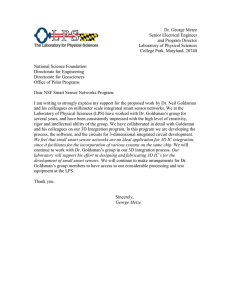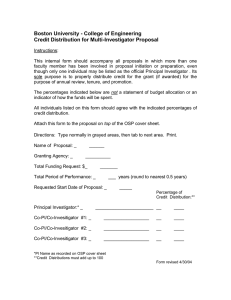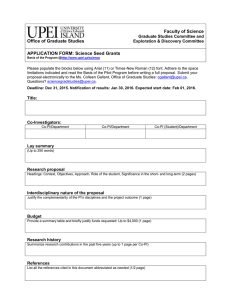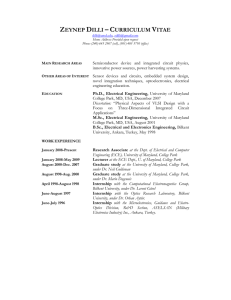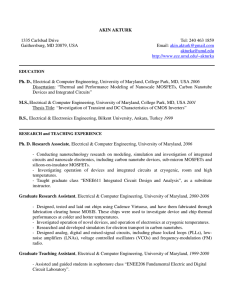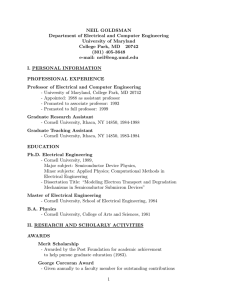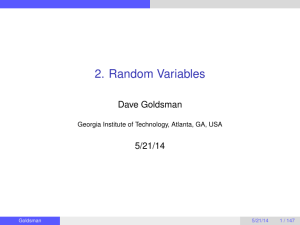NEIL GOLDSMAN Professor of Electrical Engineering
advertisement
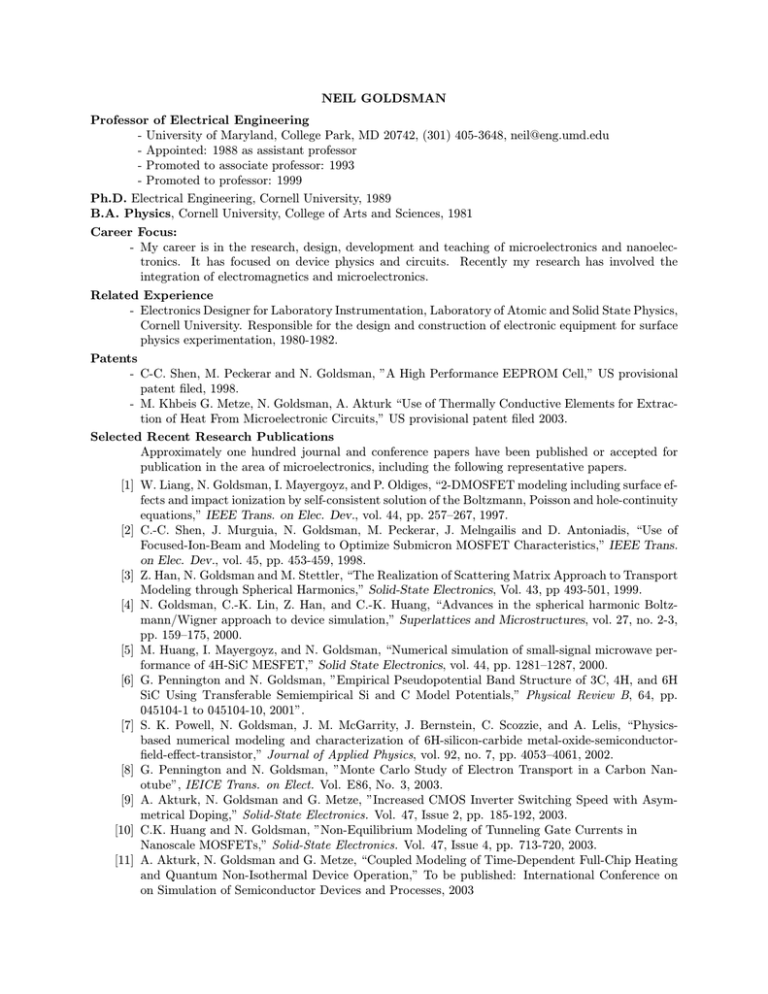
NEIL GOLDSMAN Professor of Electrical Engineering - University of Maryland, College Park, MD 20742, (301) 405-3648, neil@eng.umd.edu - Appointed: 1988 as assistant professor - Promoted to associate professor: 1993 - Promoted to professor: 1999 Ph.D. Electrical Engineering, Cornell University, 1989 B.A. Physics, Cornell University, College of Arts and Sciences, 1981 Career Focus: - My career is in the research, design, development and teaching of microelectronics and nanoelectronics. It has focused on device physics and circuits. Recently my research has involved the integration of electromagnetics and microelectronics. Related Experience - Electronics Designer for Laboratory Instrumentation, Laboratory of Atomic and Solid State Physics, Cornell University. Responsible for the design and construction of electronic equipment for surface physics experimentation, 1980-1982. Patents - C-C. Shen, M. Peckerar and N. Goldsman, ”A High Performance EEPROM Cell,” US provisional patent filed, 1998. - M. Khbeis G. Metze, N. Goldsman, A. Akturk “Use of Thermally Conductive Elements for Extraction of Heat From Microelectronic Circuits,” US provisional patent filed 2003. Selected Recent Research Publications Approximately one hundred journal and conference papers have been published or accepted for publication in the area of microelectronics, including the following representative papers. [1] W. Liang, N. Goldsman, I. Mayergoyz, and P. Oldiges, “2-DMOSFET modeling including surface effects and impact ionization by self-consistent solution of the Boltzmann, Poisson and hole-continuity equations,” IEEE Trans. on Elec. Dev., vol. 44, pp. 257–267, 1997. [2] C.-C. Shen, J. Murguia, N. Goldsman, M. Peckerar, J. Melngailis and D. Antoniadis, “Use of Focused-Ion-Beam and Modeling to Optimize Submicron MOSFET Characteristics,” IEEE Trans. on Elec. Dev., vol. 45, pp. 453-459, 1998. [3] Z. Han, N. Goldsman and M. Stettler, “The Realization of Scattering Matrix Approach to Transport Modeling through Spherical Harmonics,” Solid-State Electronics, Vol. 43, pp 493-501, 1999. [4] N. Goldsman, C.-K. Lin, Z. Han, and C.-K. Huang, “Advances in the spherical harmonic Boltzmann/Wigner approach to device simulation,” Superlattices and Microstructures, vol. 27, no. 2-3, pp. 159–175, 2000. [5] M. Huang, I. Mayergoyz, and N. Goldsman, “Numerical simulation of small-signal microwave performance of 4H-SiC MESFET,” Solid State Electronics, vol. 44, pp. 1281–1287, 2000. [6] G. Pennington and N. Goldsman, ”Empirical Pseudopotential Band Structure of 3C, 4H, and 6H SiC Using Transferable Semiempirical Si and C Model Potentials,” Physical Review B, 64, pp. 045104-1 to 045104-10, 2001”. [7] S. K. Powell, N. Goldsman, J. M. McGarrity, J. Bernstein, C. Scozzie, and A. Lelis, “Physicsbased numerical modeling and characterization of 6H-silicon-carbide metal-oxide-semiconductorfield-effect-transistor,” Journal of Applied Physics, vol. 92, no. 7, pp. 4053–4061, 2002. [8] G. Pennington and N. Goldsman, ”Monte Carlo Study of Electron Transport in a Carbon Nanotube”, IEICE Trans. on Elect. Vol. E86, No. 3, 2003. [9] A. Akturk, N. Goldsman and G. Metze, ”Increased CMOS Inverter Switching Speed with Asymmetrical Doping,” Solid-State Electronics. Vol. 47, Issue 2, pp. 185-192, 2003. [10] C.K. Huang and N. Goldsman, ”Non-Equilibrium Modeling of Tunneling Gate Currents in Nanoscale MOSFETs,” Solid-State Electronics. Vol. 47, Issue 4, pp. 713-720, 2003. [11] A. Akturk, N. Goldsman and G. Metze, “Coupled Modeling of Time-Dependent Full-Chip Heating and Quantum Non-Isothermal Device Operation,” To be published: International Conference on on Simulation of Semiconductor Devices and Processes, 2003 [12] X. Shao, N. Goldsman, O. Ramahi, P.N. Guzdar, A New Method for Simulation of On-Chip Interconnnects and Substrate Current with 3D Alternating-Direction-Implicit Maxwell Equation Solver,” To be published: International Conference on on Simulation of Semiconductor Devices and Processes, 2003 Integrated Circuits (Chips) Designed and Fabricated - We have designed numerous integrated circuits, which were then fabricated using the MOSIS prototyping facility. An example communications chip with applications to location determination is listed below with its MOSIS ID name and number. Reports for our chips were submitted to MOSIS describing the results of our design and fabrication process. - Y. Bai and N. Goldsman, MOSIS Design number: 65008; Design name: FSK; Technology: SCN3ME SUBM; (A FSK transmitter chip) (2002). Research Contracts and Grants from Industry and Government Have been PI or Co-PI on research contracts which total more than 4 million dollars. [1] Intel Corporation, “Device Modeling Using Spherical Harmonic Numerical Boltzmann” $135,000 (1998-2001); N. Goldsman (PI). [2] Maryland Semiconductor Inc, “Mixed Signal RF VLSI” $30,000 (2001-2002); (PI) (Foundation). [3] ONR, “Robust Design of Wide Bandgap Power Devices.” $300,000, (2000-2003); (N. Goldsman (PI), with J. Bernstein (Co-PI)). [4] ARL-Power and Energy (PEER), “Modeling, Characterization and Design of Wide Bandgap MOSFETS,” $165,000 (2001-2003); (N. Goldsman Project Manager). [5] Laboratory of Physical Sciences: “Heterogeneous Integration,” $1,200,000, (2001-2003); (N. Goldsman (Co-PI) with C. Lee (PI), C.H. Yang (Co-PI) and B. Jacob (Co-PI)). [6] AFOSR.Bolling, “Microwave Effects and Chaos in 21st Century Electronics,” $1,800,000 (20012004); (N. Goldsman (Co-PI), with Granatstein, (PI), E. Ott (Co-PI), T. Antonsen (Co-PI), R. Rodgers (Co-PI), J. Melngailis (Co-PI), B. Jacob (Co-PI), A. Iliadis (Co-PI), O. Ramahi (Co-PI), S. Anlage (co-PI)). Related Courses Introduced to the ECE Dept. [1] ENEE 614: Radio Frequency VLSI Circuit Design [2] ENEE 408D: Mixed Signal VLSI Design [3] ENEE 306: Electronics Design Laboratory Education Texts Written [1] Neil Goldsman, Electronics Analysis and Design: Department course text for ENEE 306. [2] Neil Goldsman and Zeynep Dilli, Introduction to Electrical and Computer Engineering: An Experiential Approach, A text written as an introduction to Electrical and Computer Engineering specially for the Maryland Governor’s Institute of Technology at the University of Maryland Selected Academic Awards: - Post Merit Scholarship: Awarded by the Post Foundation for academic achievement to help pursue graduate education; George Corcoran Award: Given annually to a University of Maryland EE faculty member for outstanding contributions to electrical engineering education; National Science Foundation Research Initiation Award; for research in microelectronics; Best Professor of the Year Award: Presented by the University of Maryland IEEE Student Branch for outstanding contributions to teaching. Professional Community Service - Journal Reviewer: Journal of Applied Physics; Applied Physics Letters, IEEE Transactions on Electron Devices, IEEE Electron Device Letters, IEEE Transactions on CAD, Solid-State Electronics, Electronics Letters - Proposal Reviewer and Panel Member: Served on several review panels for NSF. - I have served on numerous international conference committees and as session chairs including: Eighth International Conference on the Numerical Analysis of Semiconductor Devices and Integrated Circuits; Semiconductor Research Corporation Workshop on Hierachical Device Simulation via a Web-Based Simulation Laboratory; National Technology Roadmap for Semiconductors; International Conference on Simulation of Semiconductor Processes and Devices
